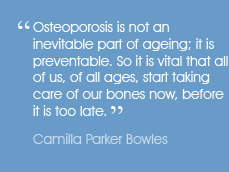
 |
 |
 |
|
| 7th December 2025 | ||
 |
Oestrogens for the prevention and treatment of osteoporosis in women below the age of sixtyJohn StuddIn spite of the evidence that estrogens produce the greatest dose dependent increase in bone density and that they have been shown to be effective in preventing osteoporotic fractures of the hip and spine their use has been relegated to second line or even unacceptable therapy in the hands of bone physicians and rheumatologists. This may be the result of the post WHI recommendations that
If so the advice is inappropriate for women under the age of 60 and in reality the physician’s objection to HRT ante dated the WHI studies by many years .Could it be that they were not comfortable with the minor side effects of HRT such as mastalgia, endometrial hyperplasia, and the PMS symptoms of progestogen intolerance which could be dealt with by any competent general practitioner?. It is worth considering the pros and cons of hormone therapy in this age group as well as outlining the disadvantages of non hormonal therapy. Although the benefits on the skeleton may be small it is not disputed that such patients be given life style advice on alcohol, smoking and exercise as well as calcium and vitamin D supplementation. In this article the value or otherwise of estrogen therapy will be discussed. The beneficial effects of estrogens should be considered noting that different symptoms need different hormone in different does by different routes depending on the age and surgical status of the woman. The one dose fits all treatment of asymptomatic 50-79 year olds of the WHI study was a decision of monumental clinical incompetence from which women now denied HRT continue to suffer. Typical menopausal symptoms of flushes, night sweats, insomnia, tiredness together with pelvic atrophy causing dyspareunia and recurrent cystitis respond well to low dose estrogens. Depression, loss of libido and other quality of life issues usually are helped with estrogens often with the addition of testosterone. In fact most patients on the correct dose and mixtures of hormones feel so well that they are unwilling to discontinue HRT after 5 or 10 years if this is the duration ultimately recommended by advisory bodies. Hence there is a reluctance to take bisphosphanates In the first three years after the menopause women lose 25% of their body collagen most notable from the skin, ligaments, tendons, nails, the intervertebral discs and the bone matrix. It has been shown that estrogens can replace the missing skin collagen and skin thickness but how does the skeletal system benefit from preservation or replacement of collagen? Histomorphometric studies of biopsies of 16 osteoporotic women taken before and after 6 years percutaneous estradiol, when the spinal bone density has increased by 28% showed a 26% increase in collagen in cancellous bone and a 7% increase in cortical bone. There was also an increase in intermediate and mature collagen cross links indicating continuing collagen production. Similar biopsy studies of 22 patients with a mean increase vertebral bone density of 29% showed an increase in wall thickness, volume of cancellous bone increased trabecular thickness The repair of the microfractures of osteoporotic bone is strongly suggested by the increase in trabecular buds and the decrease in trabecular ends. This indicates that the therapy is not merely thickening broken trabeculae but new strong bone is being produced All of these quantifiable beneficial changes have a direct significant correlation with the plasma estradiol levels achieved during therapy. There are no such studies of bone histology showing similar benefits from bisphosphanates More recent work on the intervertebral disc is equally reassuring. The discs are 100% collagen and make up ¼ of the length of the spine. Two studies performed independently have shown that estrogens protect the spine by maintaining the size of the disc space and the length of the spine. Bisphosphanates do not. This information publishes in journals of gynaecological endocrinology have not yet come to the attention of bone physicians On this evidence HRT would seem to have a better effect on flesh and bone , general wellbeing , mood and sexuality than non hormonal options. But is it safe? The optimism of HRT has been challenged by the much criticised WHI and Million Women studies which revealed an increase in breast cancer and surprisingly an increase in heart attacks and strokes when all but one case control studies indicated a considerable decrease in heart attacks. Indeed the data on heart attacks was so convincing that the prevention of coronary disease became a principle indication for HRT particularly in the USA The data collection from a single questionnaire of the Million Women’s Study is so eccentric and has been so severely criticised that it is difficult to judge the value of any of the conclusions from these papers. The extrapolation of data over time from the single questionnaire is completely unsound and it is fair to say that internationally this is recognised. A comprehensive analysis of these reviews has recently been published. On the other hand the epidemiology of the WHI study as a randomised control study was sound but they chose asymptomatic patients of the wrong age, with 22% starting therapy over the age of 70, using the wrong dose and coming to the wrong conclusions. Even though Prempro combination of Premarin 0.625 mgs and Provera 2.5 mgs as continuous therapy is not available in this country, there was still an excellent result in patients who start this therapy below the age of 60 with fewer heart attacks occurring, a slight increase in breast cancer and a significant reduction in fracture of the hip (spine), colon cancer and mortality. It seems from various studies it is the progestogen which is the risk factor for breast cancer. This the oestrogen only arm of the WHI study showed a decrease in breast cancer, heart attacks, osteoporotic fractures and mortality. As 97% of our patients on HRT start this therapy below the age of 60, this is the important group in our clinical practice. Thus there should be no proscription on the use of oestrogens, particularly oestrogens alone for the prevention and treatment of osteoporosis in women under the age of 60. Oestrogens would be the correct first line therapy in women under the age of 60 and the less effective bisphosphanates, which are not without long term side effects should be used in women where there is the rare contraindication to oestrogen therapy or those that are non responders. It should be remembered that 25% of women do not have an increase in bone density with the use of Bisphosphonates although this is a very rare occurrence in patients using HRT. The rejection of oestrogens as a simple safe and effective therapy in patients below the age of 60 is incorrect. It is also clear that the thrombogenic potential of Prempro with its continuous daily progestogen and oral oestrogen is not reproduced by the use of transdermal oestradiol. The future for the older osteoporotic patient with osteoporosis may be by this route of oestradiol as much as by non hormonal preparations with their own side effects |
|
| ^top |